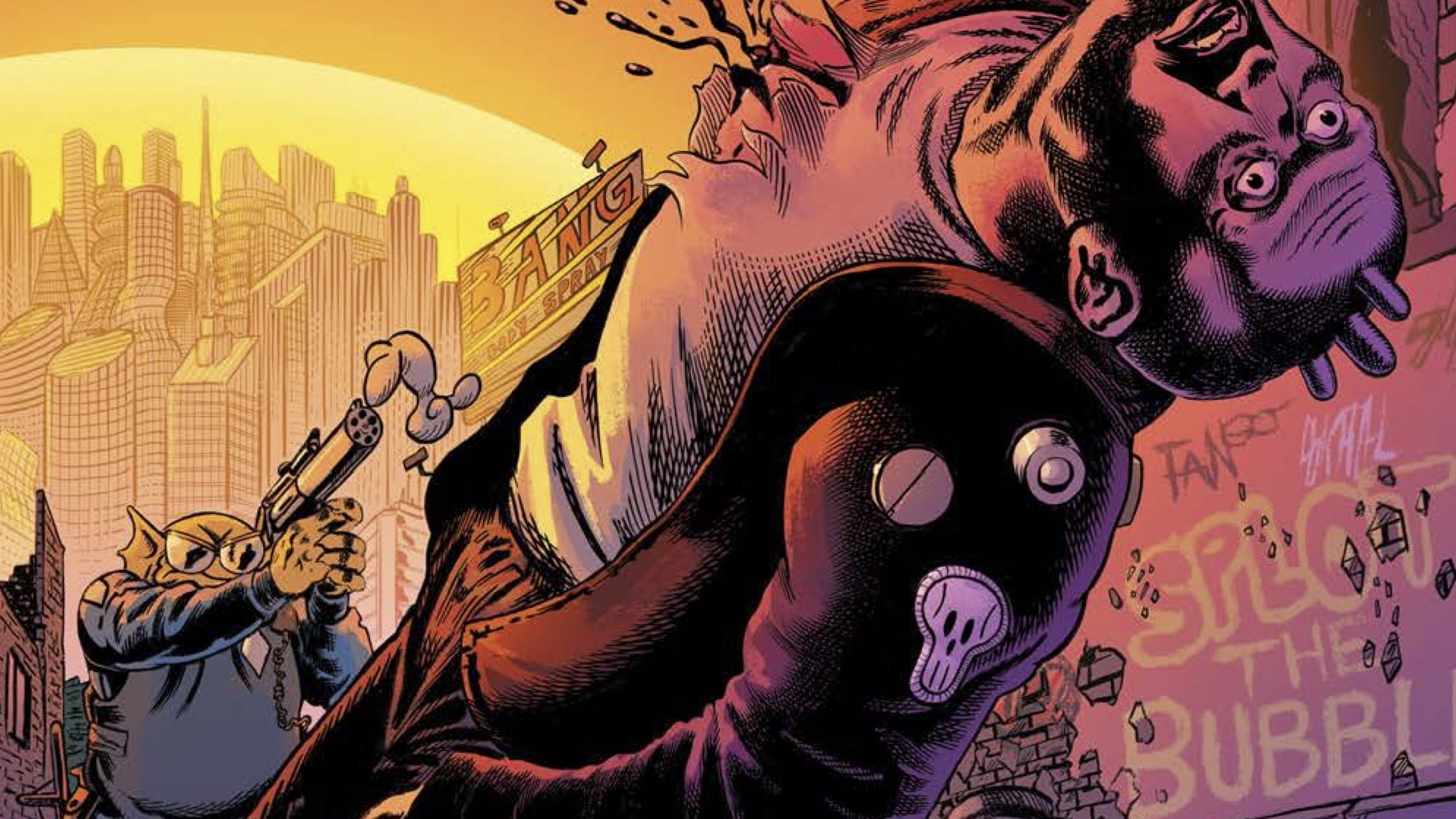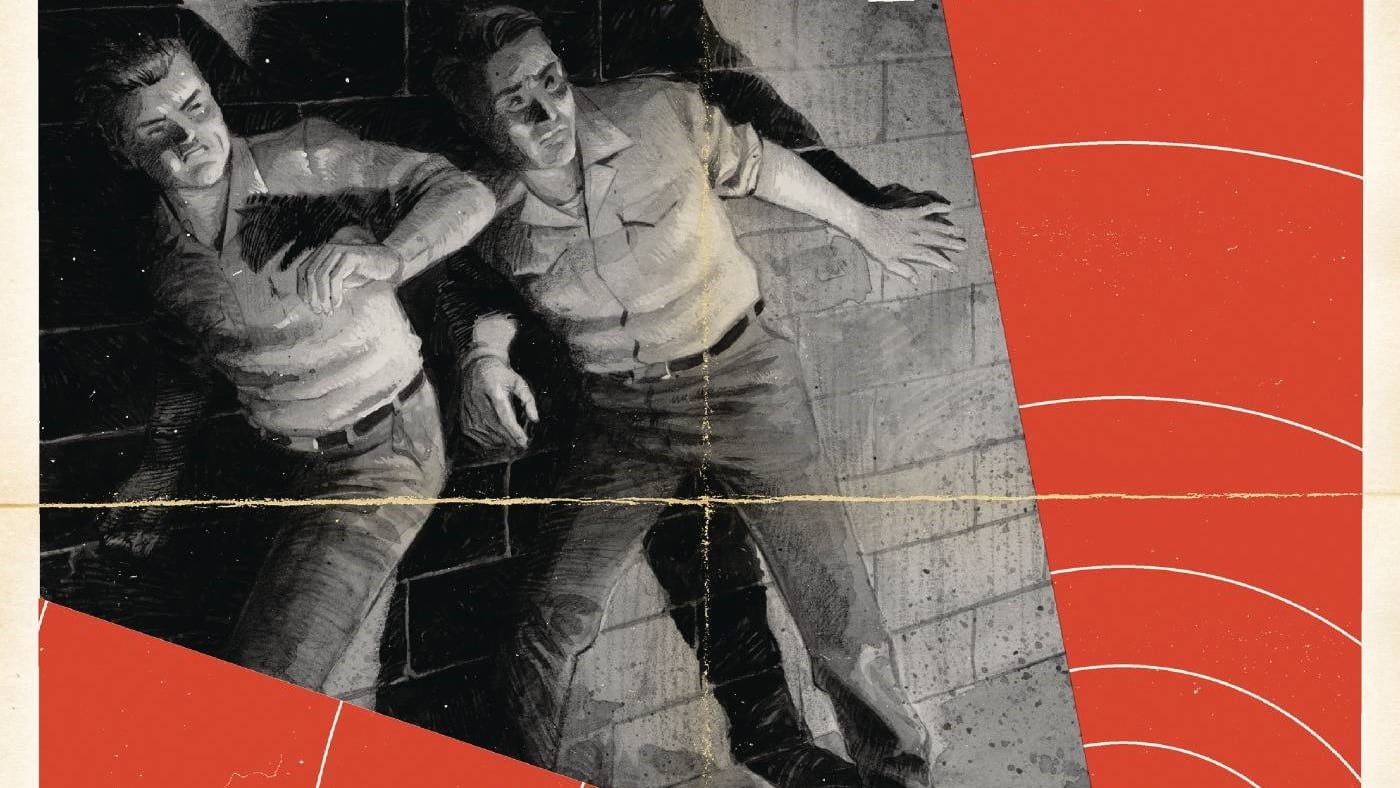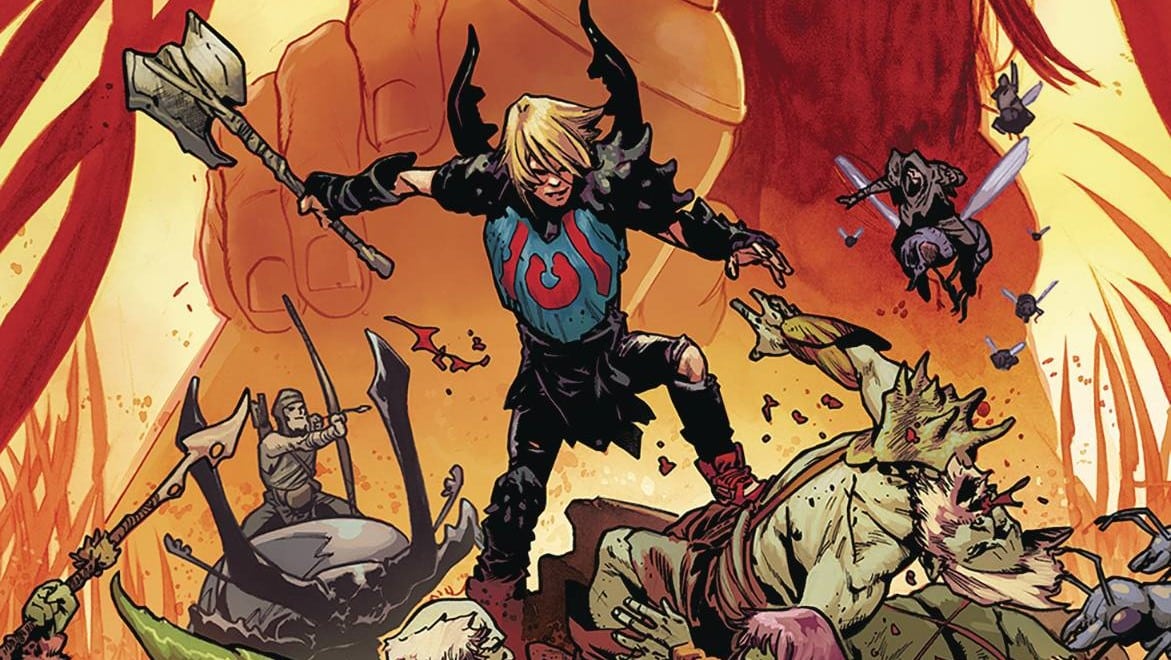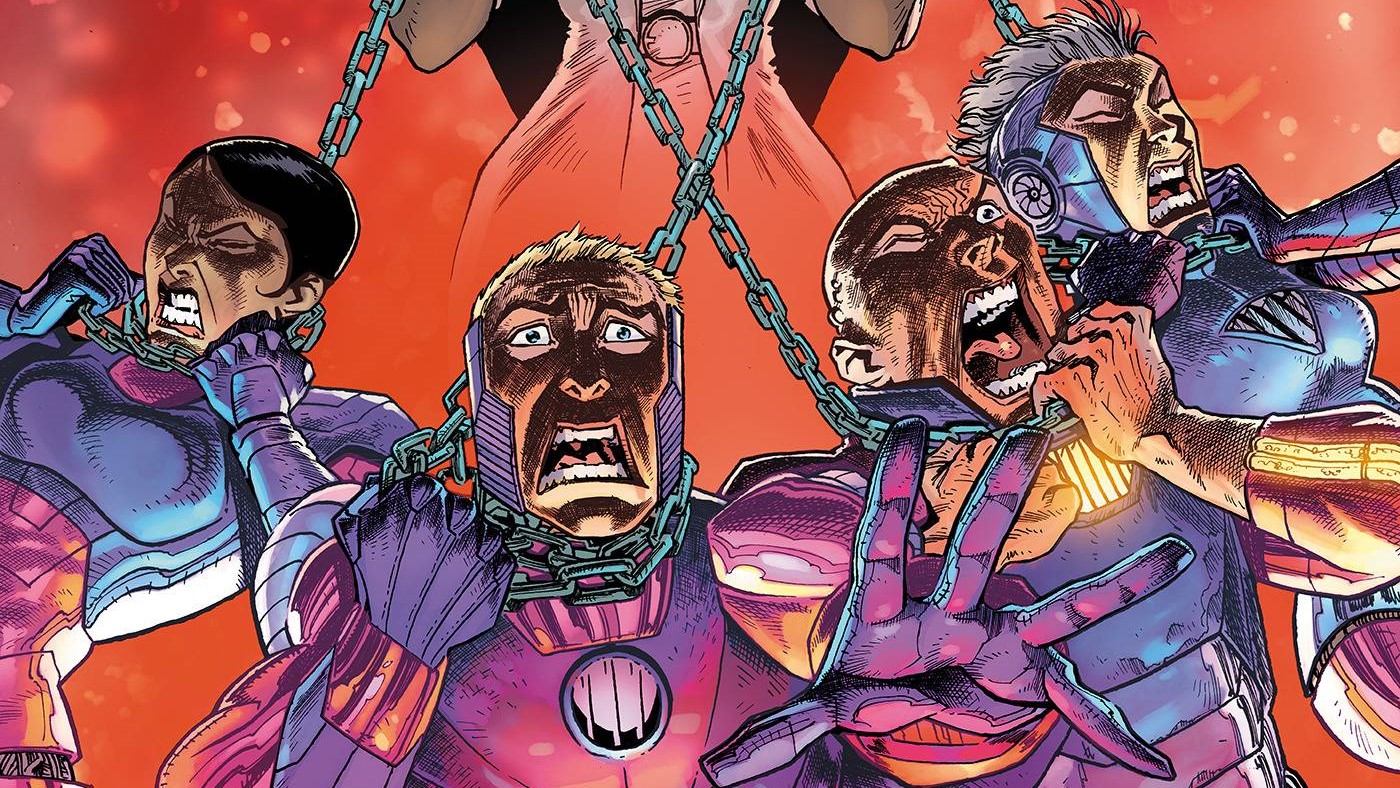In a world ruined by climate change, hope rests on humanity’s first interstellar mission. Oh, and there’s a Confederate rocket. And ghosts or something. Where Starships Go to Die #1 is written by Mark Sable, drawn by Alberto Locatelli, colored by Juancho!, lettered by Rob Steen and published by AfterShock.
The streets are mean and awfully tough when you’re a swamp monster cop and your partner is a literal piece of doody. But that’s what they signed up for in Justice Warriors #1, co-written by Matt Bors and Ben Clarkson, drawn by Clarkson, colored by Felipe Sobreiro, lettered by Bors and published by AHOY.
He’s a genius, a master planner and he cannot tell a lie — especially when he says he’s going to kill them all in A Calculated Man #1, written by Paul Tobin, drawn by Alberto Alburquerque, colored by Mark Englert, lettered by Taylor Esposito and published by AfterShock.
Will Nevin: Ian, I find AfterShock pretty interesting as a publisher — they greenlight the wildest, weirdest things, and while I find the overall batting average to be low (lower than, say, Image or rowdy, definitely-not-a-Ponzi-scheme upstart AWA) their winners are truly good. In our AfterShock sandwich this week, I’m not so sure we’ve got bread winners (See what I did there?!), but we do have good comparison publisher meat in AHOY, a house that’s much more narrow — focusing primarily on comedy and satire — but also more consistent.
Did any of that make sense?
Ian Gregory: Sorry, I stopped reading halfway through to go get myself a hot chicken sandwich. We’re doing two AfterShocks and an AHOY, right? All new series? I suppose that every new AfterShock series is a roll of the dice, but to be honest the only AHOY I’ve ever really gone for is The Wrong Earth.
Wait a minute, am I still just a superhero person at heart?
Will: *shakes Magic 8 Ball* Reply hazy, try again.
Where Starships Go to Die #1: Where Ideas Go to Multiply

Will: In the first iteration of this indie/grindhouse column, I read Sable’s Miskatonic, another Aftershock book that was steeped in Lovecraftian mythos, and found it to be largely incomprehensible. That was partly on me for not knowing my Lovecraft, but a lot of it was on the book — transitions were messy, the art was sloppy and it was an overall meh experience. Where Starships Go to Die is different in that it’s telling a wholly original story, but it still feels rough, especially where Sable (credited here as a “futurist”) is trying to do too much with story ideas.
Climate dystopia? Hey, that’s what we have to look forward to in the next few decades. Weird space stuff? Fuck, yeah, space is scary, and the laws of relativity might as well be science fiction. Confederate space exploration and demon possession? Slow the fuck down, buddy.
Ian: Is it bad that my first thought on the Confederate missile/Baltimore Gun Club stuff was Planetary? I definitely felt like the premise moved way too fast. We start with climate catastrophe and desperate attempts at space colonization, basic Kim Stanley Robinson stuff. The deep-sea ship salvage follows naturally from that and makes perfect sense. I can even buy that there’s something that came back in those spaceships, something Lovecraftian, that haunts the shipwrecks. But I do feel like once you start getting into secret histories and whatnot, you’ve lost the thread. I feel like some important character moments were sacrificed to make room for more premise, in a series that already has a lot of premise!
If we’re setting up a horror story here, trapped in a salvage operation with a bunch of evil space ghosts, then I think we need more time to establish our cast of characters. Besides our main character and his mysterious benefactor, the other members of the crew get one-panel introductions, which marks them as generally unimportant. I can’t really tell what kind of story this book wants to tell, because we’ve gotten so wrapped up in where and when it’s taking place.
Will: This was one of the books that caught your eye originally — what specifically interested you? Did you feel like any of that interest was paid off?
Ian: Well, I’ve been playing a lot of Hardspace Shipbreaker, a game about breaking down shipwrecks in space. It’s a neat little setting, and I’m always down for a little Lovecraft. There’s definitely some interesting stuff in the timeline at the very end of the issue, but if a lot of your best ideas come from a couple pages of backup, rather than being present in the story itself, then there’s a problem.
Will: Shit, I almost forgot the idea that Captain Nemo was real, and Jules Verne was actually a historian. That’s in there, too. For what should be an underwater heist book, again, this is way too complicated. Am I wrong? Do you think this thing gets turned around?
Ian: It’s possible that this needs two issues to bake before settling into the actual story, but I’m not very encouraged by this pace. I feel like Sable had a bunch of good ideas and threw them all into the same book, rather than prune it down to just the most interesting.
Justice Warriors #1: No One (With Power or Money) Is Safe

Will: This right here? Far and away the Freshest Chicken of the Week. The satire is crisp, the art is nuts and it’s funny, which doesn’t always necessarily coincide with good satire. Bors and Clarkson take the piss out of class, white flight, technology, police, kleptocracy, consumerism — basically anything that can be ethically made fun of is made fun of. Also, we’ve got a cop literally made out of shit. What a time to be alive, Ian!
Ian: This issue has a high volume of gags — we’re talking four or five gags per page here, Will. That’s a dangerous number of jokes. Besides the big premise bits, like the send-up of self-driving cars, the police and social media, there are lots of little jokes that might slip by you. Calling the poor neighborhood, outside The Bubble, “the Uninhabited Zone” is hilarious considering the majority of people live there. Furthermore, the mayor’s new album is called “My Struggle” — one guess as to the reference.
Will: I did not see that coming, Ian.
Not to rip a guy milking the same physical comedy gags he’s been doing for 30 years, but to totally do that thing, Rowan Atkinson had some galaxy-brained ideas this week on comedy, specifically, “There are lots of extremely smug and self-satisfied people in what would be deemed lower down in society, who also deserve to be pulled up. In a proper free society, you should be allowed to make jokes about absolutely anything.” He’s making the argument — if I read it correctly — that sometimes it’s OK to punch down, which, you know, is a bad idea. It’s mean spirited and is exactly the sort of thing that gets us to Dave Chappelle making fun of trans people because he thinks they’ve got power on Twitter or wherever.
Justice Warriors is the exact opposite — at no point does it stoop to mocking anyone or anything *not* part of the establishment. I feel like that’s a low bar for commendation, but with so many wannabe edgelords in comedy, it’s refreshing to see such an embrace of what should be a simple fucking principle.
Ian: At times, Justice Warriors appears to be parodying the language of leftism, social justice and The Youth, but I think each of these moments instead parody the way the establishment co-opts that language to their own ends: “We love the chief here in the zone too. She puts the crime on blast. We stan. Was that good?” In particular, I liked the way the establishment co-opts the language of mental health: “Save the trauma dump for your cell mates!” or the vapid Buzzfeed quiz-style mental health assessment.
Will: And the art. I love the art in this book — details all over the goddamned place, fun colors, great action scenes, perfect SFX (CRUNCH). Again, this chicken is fresh as hell.
Ian: Special shout-out to the column at the end about cops in comics. It’s a really funny list, and hopefully only the first of many attempts to confront comics’ long love affair with cops.
Will: We’re part of the problem, aren’t we?
A Calculated Man #1: A Division of Opinion

Will: Finally, we get to the end of our AfterShock sandwich with another popular theme here in Leftovers: organized crime! It’s like regular crime, but with rules and bosses. I’ll start first with the art on this one and say that I didn’t care for it. It’s perfectly competent, but I don’t think it matches the tone of the book.
Ian: It’s just a little too cartoony. Beans’ haircut is just a little too silly for me.
Will: Cartoony is *exactly* the word I would use, you betcha.
Ian: But I also felt like the art worked well in places, particularly with stuff like the Van Dyke gang. Art like this abstracts the violence a level, which works for me since most of the shooting and action are so far taking place off camera, so to speak. It’s not my favorite, but I think it’s trying to match the very difficult line the writing takes, which is that of a whimsical crime drama.
Will: And speaking of tone, the writing is a bit all over the place, innit? Jack Beans is a genius afflicted by the inability to lie, but he’s a master planner, able to keep both the mob’s books and devise the best strategy to whack a guy. I guess this is supposed to be a dramedy? The art makes it feel more comedic, for sure.
Ian: I’m not sure I’d say it’s all over the place, but I think it’s trying to hit a very precise mark. Jack Beans is meant to be charming, endearing and humorous, but he’s also a criminal mastermind capable of committing murder without a second thought. He exists in an organized crime world, but one boiled down to its most humorous and trope-y elements. We’re supposed to both like Jack Beans and the U.S. Marshals keeping an eye on him. It’s like Dexter by way of Monk.
Will: I dunno — overall, it felt too exposition-y, and I don’t know that I have the imperative desire to see the story of Jack Beans to its conclusion.
Ian: I have to pretty strongly disagree with you, Will. I thought this was a fun issue, and I appreciate the cleanness in revealing that everything Beans has done throughout the first issue was setup for a perfect crime. It was a lot of exposition, but I also like that it was timed well to have Beans sitting down with the Marshals right as the details of his plan come to light — that’s the dramatic irony I’m looking for. I would rather read about Beans’ somewhat whimsical approach to mass murder than any of the other half-dozen organized crime series we’ve gotten one or two issues through.
Does This Smell OK?
- Rapid fire questions:
- What’s your favorite “space is going to kill you” science fiction film?
- Will: Event Horizon
- Ian: Jason X
- What’s your favorite emoji?
- Will: The new melty face guy. Honorable mention to the half-faced salute.
- Ian: The Thumbs Up. It’s just so useful.
- What’s the highest level of math you successfully completed?
- Will: Calc I. Derivatives, bay-bee!
- Ian: Calc I and three weeks of Calc II before I realized being a computer programmer sounded like a really boring way to live the rest of my life.
- Will: I fell asleep in Calc II and dropped that baby quick.
- What’s your favorite “space is going to kill you” science fiction film?
- Sound Effects Watch: KRASH in Justice Warriors, where the rioting citizens fill each letter of the sound effect.
- Love that Officer Rogers in Justice Warriors is Just Nick Fury.
- There’s a small typo in Where Spaceships Go to Die (“Even if security was as good as it used to be when you training here”), which isn’t a big deal, but it always throws me off when one pops up in a finished book.
- Who the fuck has leftover eggs Benedict they need to reheat?
- The stars, they’re just like us: They eat leftovers, too.
- Leftover Salmon Watch: They’re appearing at the inaugural Lake Tahoe Bluegrass and Beyond Festival on Friday, July 22.







